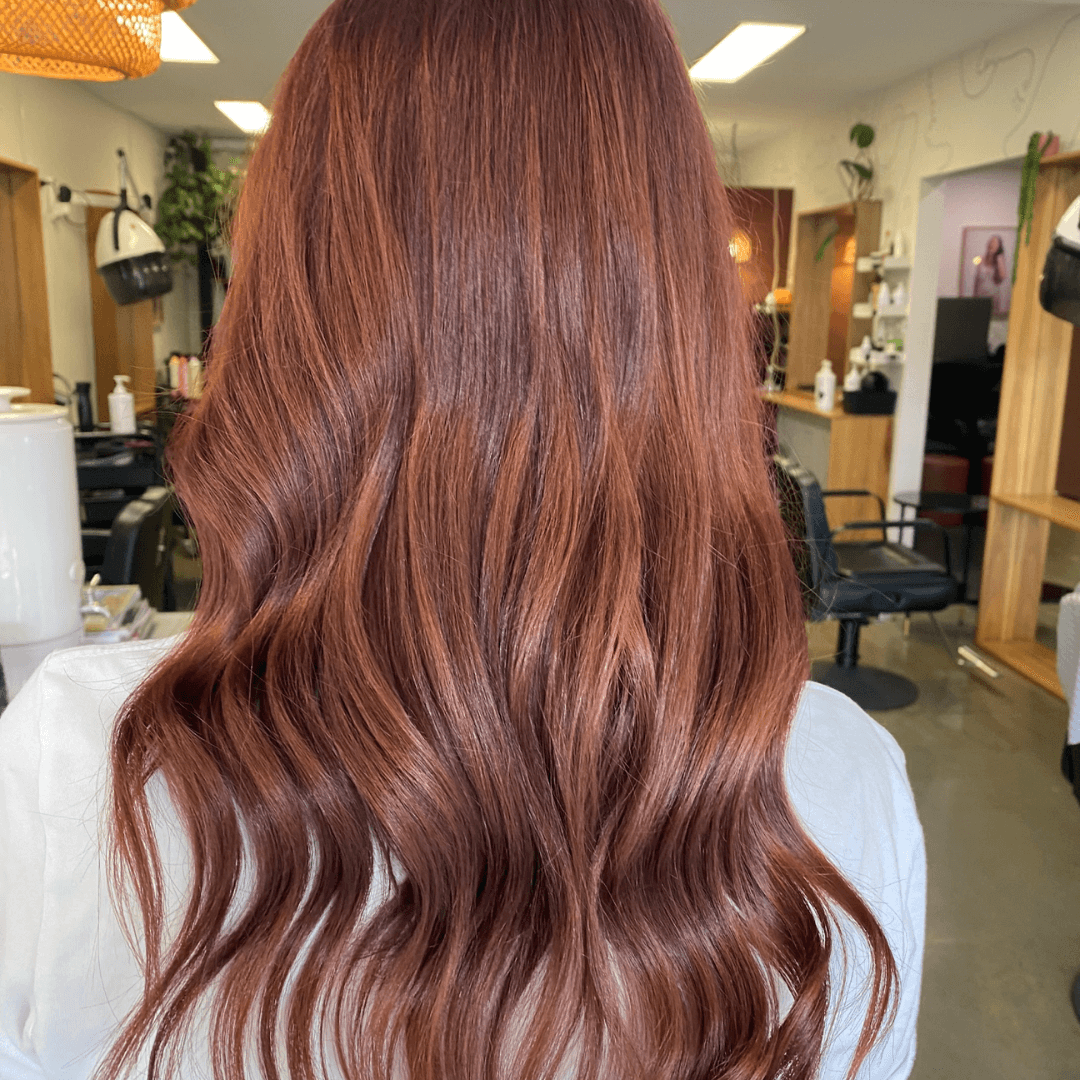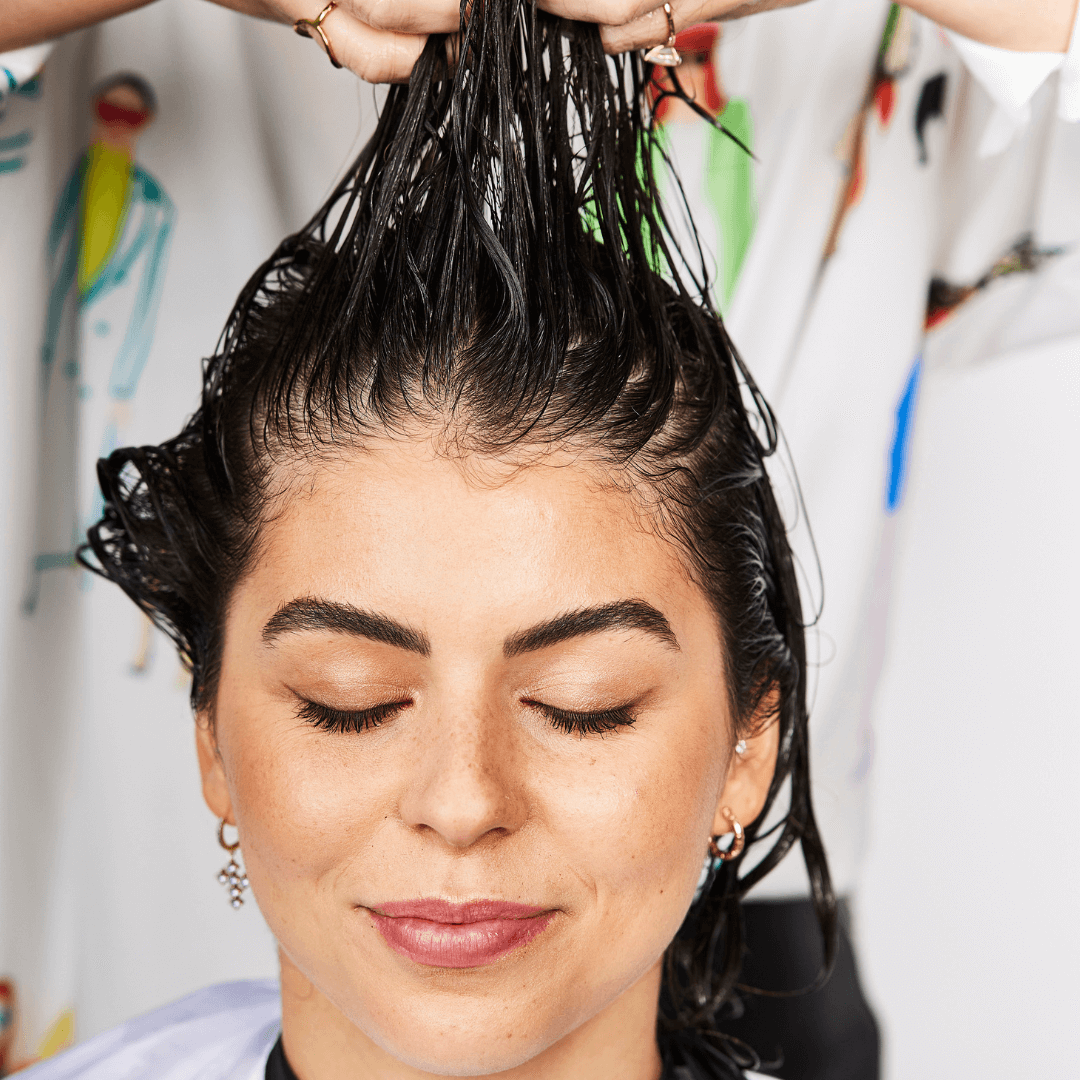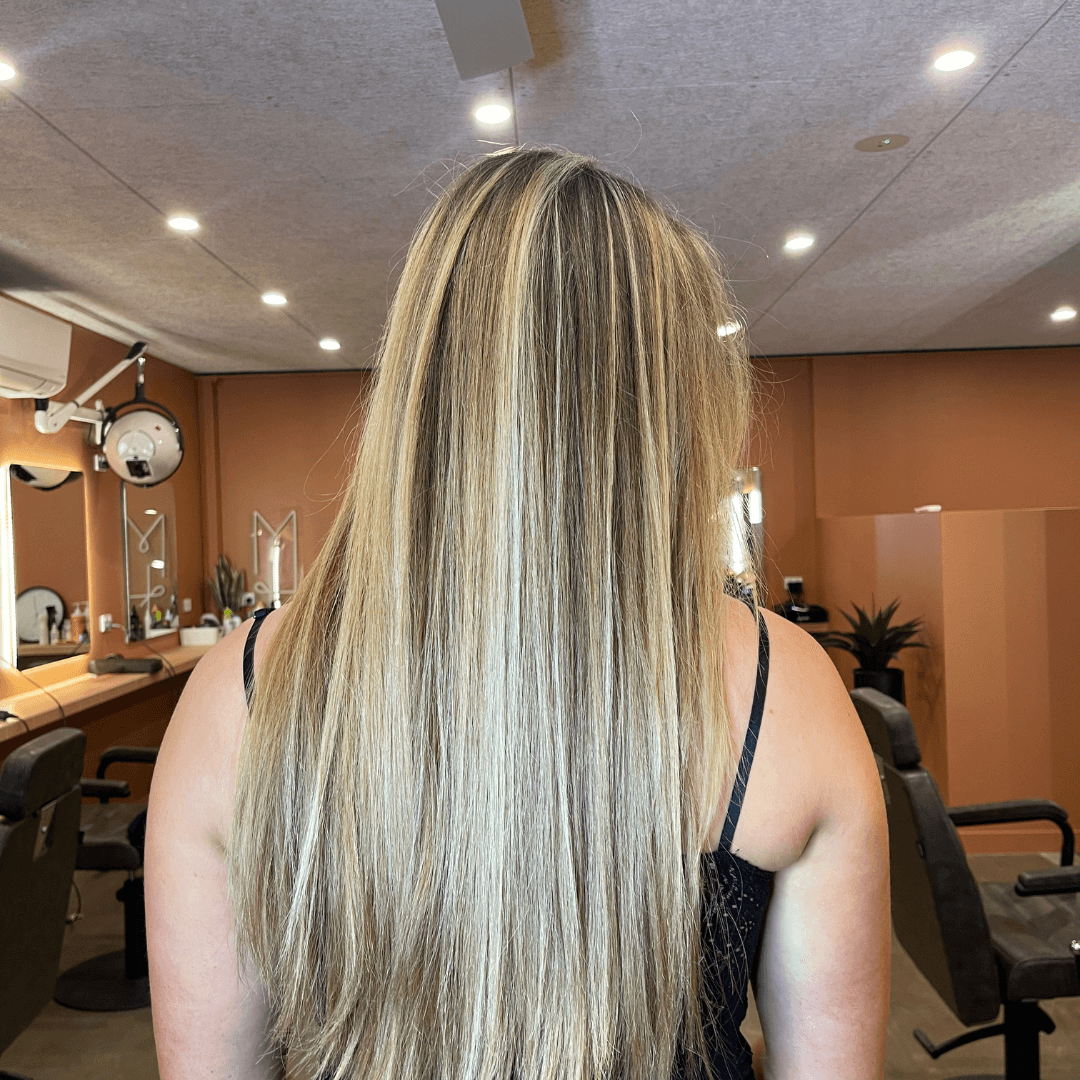Styling And Caring For Your Type 1B Hair
Learn how to identify your hair type, care for it and bring out the absolute best in its natural texture and versatility!

What Exactly is Type 1B Hair?
Type 1B hair is straight but has more body and a slight bend compared to the pin-straight Type 1A. It's characterised by its volume and subtle waves, making it versatile and easy to style. It is more often than not medium textured, although Type 1 can still have fine or a coarse texture.

Identifying 1B Wavy Hair
If you have some or all of these characteristics, you probably have Type 1B hair.
- Slightly more volume at the roots compared to Type 1A.
- Has a slight bend or wave, especially towards the ends.
- Generally easy to style and holds curls well when heat styled.
- Tends to be less oily than Type 1A.

How is 1B Different from Other Type 1 Hair?
Type 1B is different from 1A in that it has a slight wave and more body. It’s less oily and can hold styles better than the pin-straight 1A type. Its waves are only minimal compared to its sister Type 1C Hair. Type 1 C is usually coarse in texture and has more pronounced waves all the way to the scalp.
Porosity and Texture of 1B Hair
What is Hair Porosity?
One of the most talked about topics between curly guys and girls is hair porosity. What is it? How do you test the porosity of your hair and does it really make a difference to styling?
What is Hair Porosity: The porosity of your hair determines how well your hair absorbs and retains moisture.
- Three types of Hair Porosity:
- Low Porosity: Resistant to moisture.
- Medium Porosity: Balanced, absorbs and retains moisture well.
- High Porosity: Absorbs moisture quickly but loses it just as fast.
An invaluable tool for discerning the porosity of your hair, the strand test plays a pivotal role in shaping your hair care routine.
To perform the test, immerse a single strand of clean, untreated hair in a bowl filled with room temperature water, then observe its reaction. The outcome of this test will guide you in customising your hair care routine:
-
Low Porosity (Floats)
Characteristics: Tightly bound hair cuticles that lie flat, resisting moisture penetration.
Test Observation: The hair strand remains afloat on the water's surface.
Care Recommendations:
- Utilise mild heat (like a warm towel) during conditioning to facilitate cuticle opening.
- Favour lightweight products to prevent heavy residue on hair, Chutzpah Volumising Foam is perfect for Low Porosity Hair.
- Apply hair products to slightly damp hair for enhanced moisture absorption.
- Regularly use a clarifying shampoo to prevent build-up on your hair.
-
Medium/Normal Porosity (Sinks Slowly)
Characteristics: Cuticles with a moderate arrangement, promoting a balanced absorption and retention of moisture.
Test Observation: The hair strand sinks slowly, not reaching the bottom instantly.
Care Recommendations:
- Implement frequent deep conditioning to sustain optimal moisture levels.
- Intermittent protein treatments are beneficial for hair fortification.
- Strike a balance in your hair care regimen between hydrating and protein-rich products.
- Generally, this hair type is more manageable and responds well to varied treatments.
-
High Porosity (Sinks Immediately)
Characteristics: Presence of gaps or holes in the cuticle, leading to rapid moisture absorption but also quick moisture loss.
Test Observation: The hair strand quickly sinks to the bottom.
Care Recommendations:
- Apply leave-in conditioners and curl creams to help maintain moisture- we recommend Cruise Control Curl Cream to enhance texture and balanced moisture.
- Seal the moisture with thicker gels- Oomph Hydration Gel is perfect and can be used in conjunction with Cruise Control.
- Use protein treatments to fill in cuticle gaps temporarily.
- Avoid excessive heat styling and harsh chemical treatments to prevent further porosity increase.
Understanding the porosity of your Type 1B hair by doing the Strand Test can change and guide your product selection and hair care methods. Provide your hair with the necessary level of moisture and attention it deserves.

Texture of 1B Hair
- Fine Texture: Thin strands that may lack volume but are easy to style.
- Medium Texture: The most common in 1B hair, offering a balance between strength and volume.
- Coarse Texture: Thicker strands, often more resilient and prone to dryness.
Fine Texture
Type 1B hair with a fine texture consists of thin individual strands. While this texture may present challenges in terms of volume, it compensates with its silkiness and ease of styling. Fine hair tends to lay flat against the scalp and can appear sleek and shiny. However, it may also be more susceptible to oiliness, requiring careful selection of hair care products. Lightweight volumising products like Chutzpah Volumising Foam can be particularly beneficial for this hair type, as they add the desired body without causing buildup.
When styling fine 1B hair, it's essential to avoid heavy products that can weigh the hair down, opt instead for light mousses or foams that enhance texture and volume.

Medium Texture
Medium-textured 1B hair strikes a perfect balance, making it the most common and versatile within the Type 1B category. This texture boasts a combination of strength and volume, allowing it to hold styles well while maintaining a natural bounce and lightness. Medium-textured hair is less prone to oiliness compared to fine hair and can handle a wider range of products, including light oils, leave-in conditioners and curl creams. It's resilient enough to withstand various styling techniques, from occasional heat styling, diffusing to air-drying, without showing immediate signs of damage. Regular maintenance, like trimming and routine hydration, can keep medium-textured 1B hair looking healthy and vibrant.
Coarse Texture
Coarse-textured 1B hair features thicker strands, providing a robust and resilient quality. This texture is less common in Type 1B hair but stands out due to its volume and distinct feel. While coarse hair is strong, it is often more prone to dryness and may require more intensive moisturising routines. Deep conditioning treatments and rich hydrating products are beneficial for maintaining its health. Coarse hair can also hold styles well but may require more effort to manipulate due to its thickness. Embracing curl creams, foams and gel for curly hair, while avoiding products that contain drying ingredients like sulphates, can help in keeping coarse 1B hair well-moisturised and manageable.

Caring for Your Type 1B Hair
Proper care is crucial to maintain the health and look of your 1B hair. Here are four simple things you can do to make your Type 1B hair shine!
- Regular washing with a sulphate-free shampoo
- Using a lightweight conditioner
- Prevent dryness by not over washing.
- Incorporate a deep conditioning treatment every couple of weeks.

Step-by-Step Guide for Washing Your Type 1B Hair
Step 1: Pre-Wetting Your Hair
- Begin by thoroughly wetting your hair with lukewarm water. Ensure that your hair is completely soaked, as this will help evenly distribute the shampoo and effectively remove dirt and oil.
Step 2: Applying Shampoo
- Take a suitable amount of LOHY’s sulphate-free Nourish & Flourish Shampoo in your palms. Sulphate-free formulas are gentler on the hair and won't strip its natural oils.
- Gently massage the shampoo into your scalp using your fingertips. Focus on the scalp area, as this is where most oil and dirt accumulate. Be sure to avoid harsh scrubbing which can tangle your hair and irritate your scalp.
Step 3: Rinsing Out the Shampoo
- Rinse your hair thoroughly with lukewarm water. Make sure all the shampoo is washed out, as any residue can make your hair look dull and weigh it down. For best results, repeat this process x 2.
Step 4: Applying Conditioner
- Squeeze out the excess water from your hair, and then apply LOHY’s lightweight Nourish & Flourish Hydrating Conditioner. This type of conditioner is ideal for 1B hair as it moisturises without heaviness.
- Concentrate on applying the conditioner to the ends of your hair, which are typically the driest parts. Avoid applying too much conditioner to the scalp to prevent greasiness.
Step 5: Final Rinse
- Rinse your hair with cool water. Cool water helps to close the hair cuticles, locking in moisture, reducing frizz, and leaving your hair smooth and shiny.
This step-by-step guide ensures that your Type 1B hair is cleansed properly, leaving it clean, hydrated, and manageable. Remember, the key to healthy hair is not only in the products you use but also in how you use them.

Moisturising and Hydrating Your 1B Hair
Maintaining the moisture balance in Type 1B hair is crucial for its health and appearance. Hydrating your hair properly can combat issues like dryness and frizz, giving your hair a healthy shine and improved texture.
- Leave-in Conditioners: These are perfect for daily moisture without the heaviness. They help in detangling and smoothing your hair, making it more manageable. Apply a small amount to damp hair, focusing on the mid-lengths to ends, where dryness is most common. Look for formulas that contain natural hydrators like aloe vera or glycerin.
- Hair Masks: Using a hydrating hair mask like Drench & Quench Nourishing Mask once a week can deeply nourish your hair. These treatments penetrate the hair shaft, providing lasting hydration and repairing damage. Choose masks rich in ingredients like keratin, argan oil, or coconut oil for deep nourishment.
Pro-tip: Creating a DIY leave-in conditioner using LOHY's Nourish & Flourish Hydrating Conditioner is an excellent option for saving money and using products that you already know and love. Not to mention they add extra hydration and manageability to your hair care routine.

Here's a step-by-step guide to making your own leave-in conditioner:
Ingredients and Tools Needed:
- LOHY's Nourish & Flourish Hydrating Conditioner.
- Distilled water.
- A clean spray bottle.
- A small funnel (optional, for easier pouring).
- An essential oil of your choice for fragrance (optional- we recommend Rosehip, Patchouli or alternatively you can use a drop of HUSH Nourishing Oil. )
Step-by-Step Guide:
Step 1: Prepare Your Ingredients
- Ensure that your spray bottle is clean and dry. This will help prevent any bacterial growth and ensure that your leave-in conditioner stays fresh.
Step 2: Mixing the Conditioner and Water
- Fill the spray bottle about one-third of the way with Nourish & Flourish Hydrating Conditioner. This amount can be adjusted depending on the length and thickness of your hair.
- Add distilled water to the bottle until it's nearly full. The ratio should be approximately one part conditioner to two parts water, but you can adjust this depending on how lightweight you want the mixture to be.
Step 3: Adding Essential Oils (Optional)
- If you wish to add fragrance to your leave-in conditioner, now is the time to do it. Add a few drops of your chosen essential oil (or Hush) to the mixture. Essential oils like Rosehip or Patchouli not only add a pleasant scent but can also have additional benefits for your hair.
Step 4: Shake to Combine
- Close the bottle and shake it vigorously to mix the conditioner, water, and essential oil (if used). Ensure that the mixture is thoroughly combined. The result should be a milky, easily sprayable liquid.
Step 5: Testing the Consistency
- Test the spray on a small section of your hair to ensure the consistency is right. It should be light enough to spray but creamy enough to condition your hair. If it's too thick, add more water; if too light, add more conditioner.
Step 6: How to use it?
- To use, spray the DIY leave-in conditioner on damp hair, focusing on the mid-lengths and ends. Avoid the roots to prevent greasiness.
- Use your Flexi Brush to gently comb through your hair to distribute the product evenly.
- Style as usual.
Storage and Shelf Life:
- Store your DIY leave-in conditioner at room temperature and use it within a week for best results. Since this homemade conditioner doesn't contain preservatives, it's best to make it in small batches and use it quickly.
This DIY leave-in conditioner is a cost-effective and easy way to add extra hydration to your hair care routine, especially for those with dry or frizzy hair types.

Deep Conditioning Treatments for Type 1B Hair
Deep conditioning treatments are essential for maintaining the health and vitality of your 1B hair. Treating your hair with Drench & Quench Hydrating Mask can help restore hydration, enhance shine, and improve overall hair texture.
- Frequency: Aim to deep condition your hair every two weeks. This routine can help replenish moisture lost due to environmental factors and styling.
- Selecting Products: Opt for lightweight formulas that provide intense moisture without leaving a greasy residue. LOHY’s Drench and Quench Hydrating Mask is packed with moisturising Ingredients like coconut oil and jojoba oil. These oils are excellent for hydration while being light on the hair.
Overnight Treatments: For extra dry hair, overnight deep conditioning treatments can be very effective. Apply the treatment to your hair, cover it with a shower cap, and leave it on while you sleep. This extended period allows for maximum penetration of the product. However, ensure you rinse it out thoroughly in the morning to avoid any residue.

Using Oil on Type 1B Hair
Incorporating oil into your hair care routine can add an extra layer of moisture, tame frizz, and add a healthy shine.
- Application: Apply a small amount of Hush Nourishing Oil to the ends of your hair. This area tends to be drier and more prone to split ends. The oil will help seal in moisture and protect the hair from further damage.
- Benefits: The right oil can make a significant difference in the appearance and health of your hair. It can add shine, reduce frizz, and make your hair feel softer and smoother. Oils like the Hush Nourishing Oil are formulated to provide these benefits without making your hair greasy or heavy.
By incorporating moisturising and hydrating practices into your hair care routine, you can ensure that your Type 1B hair remains healthy, shiny, and well-nourished.
Step-by-Step Styling Guide for Type 1B Hair
Achieving a subtle wavy look with LOHy’s range of curly hair products is straightforward and can be done in six easy steps:
- Begin by washing your hair with Nourish & Flourish Shampoo and follow up with Nourish & Flourish Conditioner. This duo cleanses and hydrates your hair, preparing it for styling.
- After washing, with your hair still damp, evenly apply Cruise Control Cream. Use your fingertips or a Flexi Brush to rake the product through your hair from roots to tips. This technique helps in forming 'curl clumps,' laying the groundwork for your waves.
- Flip your head upside down and gently scrunch your hair with your hands. You should hear a ‘squelchy’ sound as you do this, indicating that your hair is well-hydrated, which is essential for forming beautiful waves.
- For extra hold, now’s the time to use Chutzpah Volumising Foam or Oomph Hydrating Gel. Lightly glaze these products over the ends of your hair and work your way up towards the roots. This step ensures that your waves hold their shape longer.
- Use a blow dryer with a diffuser attachment to dry your hair. Hover the diffuser over your hair, and for added volume, continue this process while your head is flipped upside down, gently moving your hair from side to side.
- If you’ve used Oomph Hydrating Gel or POW Strong Hold Gel, wait until your hair is completely dry and then softly scrunch out any 'crispy' areas. This final step will leave you with soft, natural-looking waves that maintain their shape throughout the day.
Following these steps will help you achieve waves, using LOHY’s specialised products, perfect for a casual, laid-back style. Turn your straight hair into subtle waves, effortlessly.
If a more chic updo is the look you’re wanting, follow these simple ‘how to’ guides below.
More Styles for Type 1B Hair
Type 1B hair, with its slight wave and body, offers versatility in styling. We’ve listed the top hairstyles for Type 1B hair in 2023.
5 Hot Tips For Your 1B Hair
- Use a silk pillowcase to reduce frizz.
- Detangle with a Flexi Brush or wide-tooth comb.
- Limit heat styling.
- Trim regularly to prevent split ends.
- Use dry shampoo to refresh your roots.
Styles and Haircuts for 1B Hair
Change is as good as a holiday, and a new style and haircut might be just the change you’re needing!
FAQs
How do you treat Type 1B hair?
Regular washing, conditioning, and minimal heat styling.
What shampoo is best for 1B type hair?
LOHY’s of course! A sulphate-free, hydrating shampoo.
Does 1b hair need conditioner?
Yes, a lightweight conditioner like Nourish & Flourish is ideal
How do you sleep with Type 1B hair?
Consider a loose braid and a silk pillowcase to prevent tangles.
What is the difference between 1B and 1A hair type?
1B has more body and a slight wave compared to the pin-straight 1A.
How to do the pineapple hair?
Gather hair into a loose, high ponytail on top of your head.











